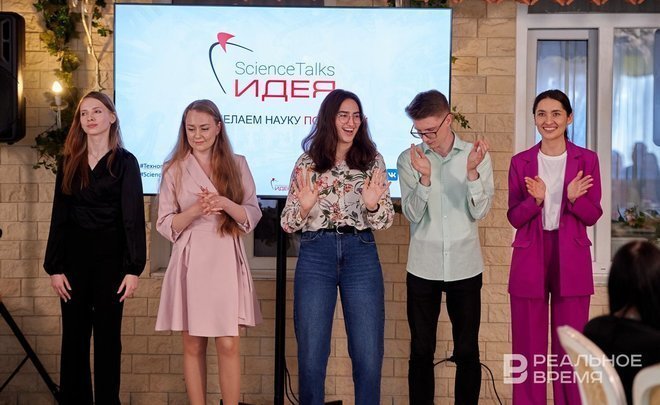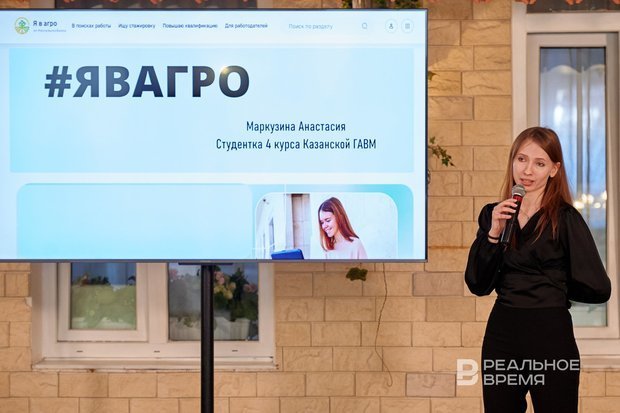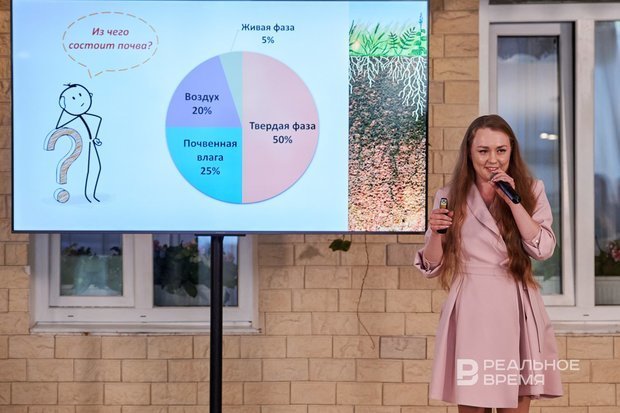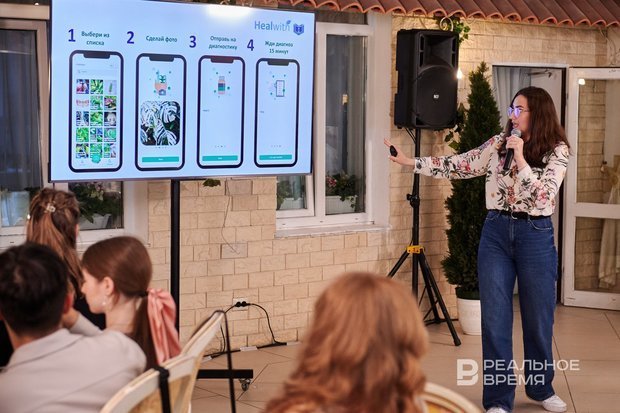Scientific stand-up in Kazan: extreme microbes, children with strabismus, and diagnosis for a flower by photo
What students and postgraduates discussed at the anniversary ScienceTalks organised by Idea technopark

The 20th anniversary session of the ScienceTalks scientific stand-up has been held in Kazan. For many months, Idea technopark has been working with talented scientific youth, “upgrading” the skill of public speaking of young scientists. Both a teacher with experience and a student can become a speaker. This is not a scientific conference: the speaker's task becomes to tell so that everyone understands — just about a complex thing, accessible about a specific thing. Five young scientists take part in each episode of the stand-up, and the best one is chosen by audience voting. And in the role of “Pavel Volya” — the mentor of the School of Speakers of Idea Technopark, Evgeny Malikov, who leads and moderates the event, and also prepares participants for the speech. We share what the participants of the anniversary “scientific stand-up” talked about.
Promoting the service, of which you are the ambassador
Anastasia Markuzina, a student of the Kazan State Academy of Veterinary Medicine, presented not her own project. But since she is part of the pool of student ambassadors of the “I'm in Agro” platform, she decided to use the ScienceTalks project as another platform for her promotion. So at least she got five points for the business task with her presentation.
The platform that provides young people with opportunities for training and employment in the field of agribusiness is a project of one of the Russian banks. The bank chooses its scholarship holders among the students of specialised universities, who then become one of the ambassadors of its projects.
Anastasia is an example of an active student. She is not only a scholarship holder of the bank, she also has her own business in the service sector. Despite that there were no own scientific and technical developments in her speech, but the audience saw a living example of how to earn points on their own social activity.

Loving the ground under your feet
Anastasia Akhrarova's speech from the Agrarian University was dedicated to the soil. It was the format of a popular science lecture, interesting and comprehensible. The audience saw a different pole: a soil scientist in love with her work enthusiastically talks about how she digs two-meter soil sections and comes up with how to make correct diagnoses for soils. After all, after a long anthropogenic impact, the land becomes less fertile.
Anastasia made a kind of essay on the study of the soil, lively and interesting: there were no dreary notes of a purely scientific report in it. Vivid metaphors, a comparison of the soil with the human body, interesting diagrammes and a great love for the subject under study became the features of the student's speech.
There was a lot to learn from her speech. For example, that the soil can be painted almost in all colours of the rainbow. Or that its fertility depends on the calcium content in it. Or that scientists study the soil by manually digging out a two-metre pit and taking samples from each layer. And then they analyse its physical, chemical and biological properties.

Diagnosing your geranium with a photo and becoming a millionaire
Regina Ramazanova is a master's degree from the Kazan Power Engineering University. She studied electric power engineering. However, she came to the scientific stand-up to present the Healwith mobile application. Moreover, she has already won the Student Startup competition with it and received a million rubles for the development of her project. So what is it?
Every fifth plant on the Earth suffers from some kind of disease or is damaged. This is the world statistics. At the same time, not only many businesses (for example, flower shops or agricultural firms growing wheat) are “tied” to plants, but also, in principle, life on Earth.
The application developed by Regina and her colleagues is able to determine from a photo whether a plant is affected, and if so, what is the name of its ailment. The young woman explains the practical benefits of her project: for example, a person bought an expensive houseplant as a gift to her mother, and it died a month later. This could have been avoided by “scanning” the plant before buying through the app. Or, for example, it costs about 650,000 rubles to sow a field with corn. At the same time, crop losses in the world for one reason or another are estimated at $75 billion annually. And everyone has a chance to get into this statistic. But if you know in time that the crops are sick (and what they are sick with), they can be saved.
Diagnosis by photography is based on artificial intelligence technology, which compares the sent picture with millions available on the Web and determines with an accuracy above 90% what kind of disease has affected your green friend. However, so far the application knows only 35 species of plants. But Regina wants to teach it to work on a larger scale in the future: firstly, to identify plants independently, and secondly, to expand the base of diseases that can be detected.

Putting extreme microbes at the service of farmers
Dmitry Samusik from the KNRTU-KCTI, a student of the Department of Food Biotechnology, also presented a project interesting to farmers. It works with extremophilic microorganisms: these are microbes that are able to live in the harshest environmental conditions. There are many such microorganisms (mainly bacteria) on Earth. They live in the boiling water of geysers, under monstrous pressure in the ocean waters, breathe methane in the vents of volcanoes and survive freezing in the Antarctic ice. The researcher's choice fell on halophiles — huge concentrations of salt in the medium.
Dmitry works with halophilic bacteria — these are organisms that are able to live in an extremely concentrated salt solution. Even in a 30% solution, they will feel great (unless they ask for supplements). What are these microorganisms needed for? It's very simple: such bacteria can help agricultural farms that are experiencing the problem of over-fertilisation and salinisation of soils. This condition of the soil can be corrected by fertiliser, which is based on halophilic microorganisms. Once in the ground, they will “eat” the excess salts in it, and even stimulate an increase in fertility.
The task of the scientific group in which Dmitry works is to create a biological product based on halophilic microorganisms. The bacteria have already been isolated (the salt marsh from which they were taken was found in Astrakhan), and now it is being decided in which form the biopreparation will be more effective — in liquid or in tablet form.

By the way, looking ahead, we will say: Dmitry was recognised as the best speaker of the session!
Saving a child from the fate of Penelope Cruz with the help of Glazastik Push
Graduate student of the Kazan State Medical University Yulia Abdullina was the only one whose speech was not related to agriculture. She presented a simulator game for children with strabismus “Glazastik Push”.
Her speech was also very informative: for example, she showed everyone present how a person suffering from strabismus sees the world (it's very simple: you have to close one eye). A person with strabismus does not have a three-dimensional and relief picture of the world. He does not see the 3D picture, his image is distorted, because in order to turn off the wrong picture, the brain turns off one eye. The problem is widespread: it turns out that every fiftieth child in Russia suffers from it. By the way, the stars also suffer from strabismus: Paris Hilton, Marilyn Monroe, Selena Gomez, Penelope Cruz... There are many methods of treatment, one of them is “flash”. Every day for 20 minutes, the child should perform an eye exercise. He is bored, uninterested, and he does not understand why all this is being done.
A group of scientists from the medical university came up with an application for children that combines a simulator and a desire to play. The main fairy-tale hero is a rabbit, Glazastik Push. Children perform the same eye exercises, but in a playful, stimulating way. The rabbit in this story also suffers from strabismus and, passing through various levels, is cured together with the child.
The application is under active development so far: the logo, the concept of promotion is already ready, agreements have been reached with leading ophthalmologists and game designers, there are accounts in social networks and a website. After launching the application, the team plans to work with the Ministry of Healthcare and the Association of Ophthalmologists (doctors will be able to recommend the application to their patients, through them it is planned to be distributed).

As always, the event was held at a high level, and the speakers showed a completely professional level of performance. They not only can tell just about the difficult, but also captivate the audience with their enthusiasm. Idea Technopark continues to follow its vocation and work with talented youth. Its technical and scientific initiatives will definitely be supported, and the ranks of young technology entrepreneurs will be replenished with students with burning eyes coming to the ScienceTalks stage.